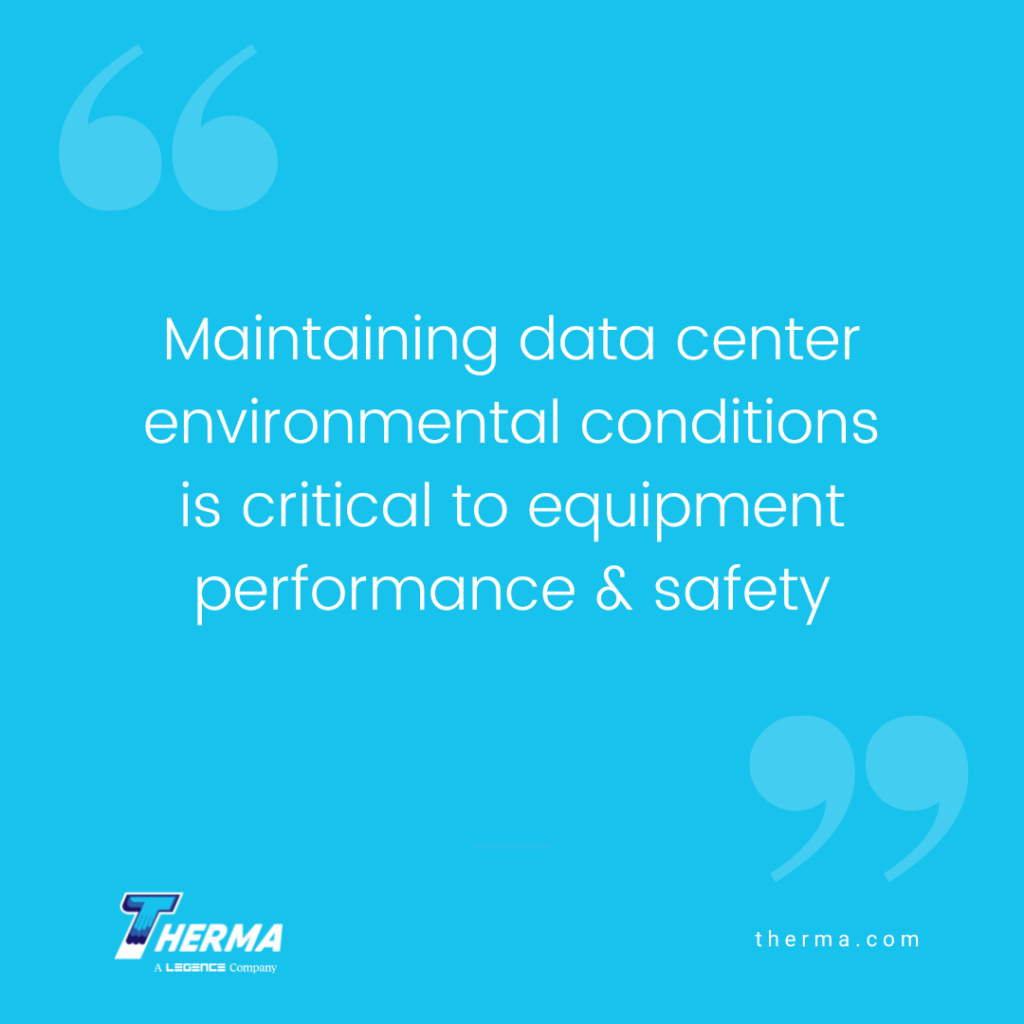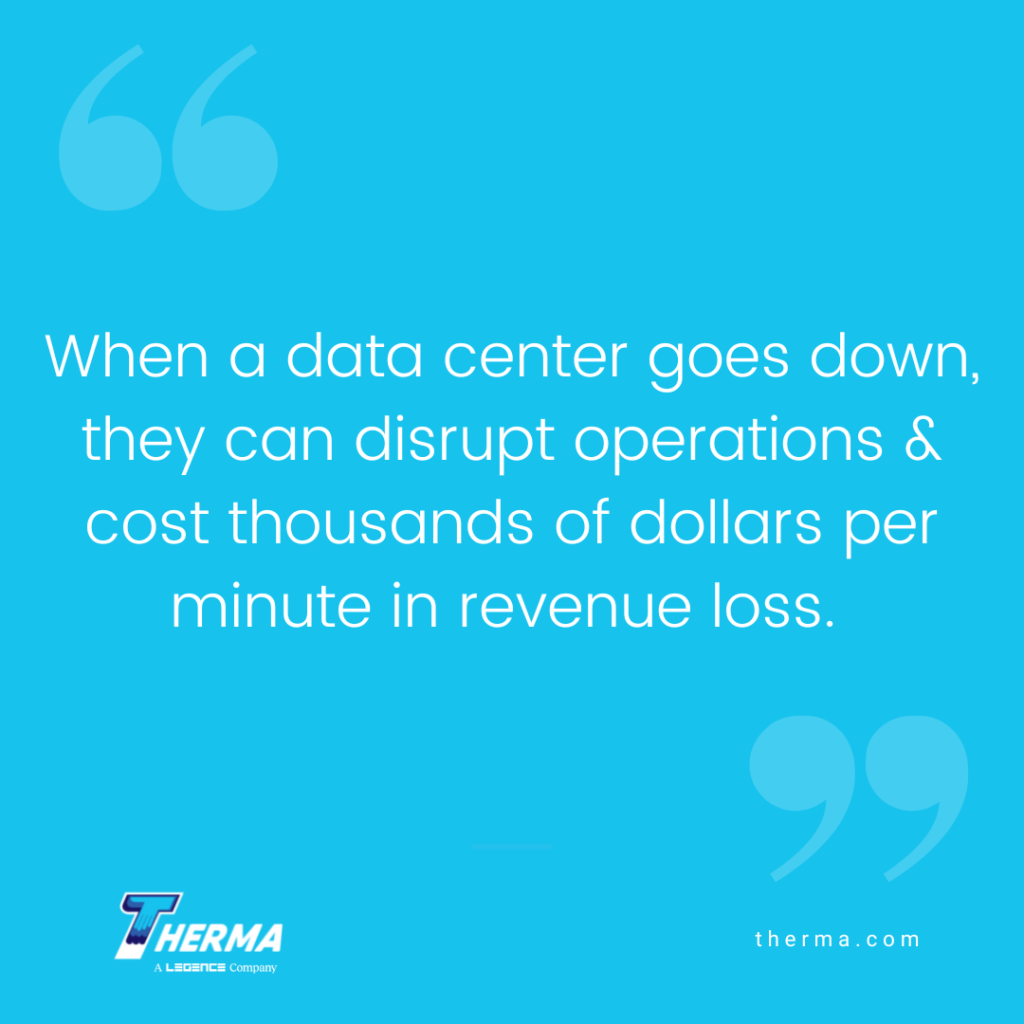by Ali Kriscenski
Data centers are superhighways of technology and information that support business operations. These centers are designed with precision and intention, to protect equipment, devices and connections that have little tolerance for fluctuations in environmental conditions. This article looks at how to manage data center cooling to maintain the efficiency and functionality of your capital investment.
What Is a Data Center?
Data centers are facilities that house networks of computing and storage devices for business applications and data distribution. They are a physical network of routers, switches, firewalls, storage systems, servers and controllers. Data centers can be utilized by companies that have a heavy reliance on IT, perform under strict data regulations, or rely on significant intellectual property (IP).
Private data centers allow businesses to fully customize the configuration of servers and storage devices. Organizations that are highly regulated, such as hospitals or banks, can utilize data centers to protect the private data of information and customers. Companies that produce high levels of IP can use data centers to protect research and other valuable business development information.
Data centers are dynamic environments that require equipment cooling and proper conditions. Like PCs, which require local cooling and exhaust of thermal energy, data centers are scaled-up versions with numerous racks producing varying thermal energy. Without proper design and environmental controls to adjust temperature and humidity, thermal energy can transfer between the equipment and cause overheating and condensation, which can lead to defaults and data disruption.
 Temperature and Humidity
Temperature and Humidity
In terms of data center cooling, a focus on temperature and humidity can create the optimal environmental conditions. The American Society of Heating, Refrigerating and Air Conditioning Engineers (ASHRAE) has been setting standards for data center environmental conditions since 2004. While ASHRAE defines data centers into four classes (based on equipment type): A1, A2, A3 and A4.
The standards vary between equipment classes, with A1 having the strictest requirements. ASHRAE provides standards for acceptable ranges and recommended ranges for each class creating a range of temperature and humidity that yields the best equipment performance.
Managing Data Center Conditions
Managing modern data center cooling is paramount to maintaining business operations. To maintain optimal data center environmental conditions, the HVAC system must be able to regulate temperature, humidity and energy consumption.
ASHRAE standards recommend that equipment be kept between 64 and 80 degrees Fahrenheit as the optimal range. However, each class has a wider allowable operating range. The guidelines are:
- A1: Operating temperatures should be between 59°F (15°C) and 89.6°F (32°C).
- A2: Operating temperatures should be between 50°C (10°F) and 95°C (35°F).
- A3: Operating temperatures should be between 5°C (41°F) and 40°C (104°F).
- A4: Operating temperatures should be between 5°C (41°F) and 45°C (113°F).
Humidity ranges are also defined by equipment class by ASHRAE. The standards include parameters for dew point and humidity:
- A1: Maximum dew point should be no more than 17°C (62.6°F).
Relative humidity should be between 20% and 80%. - A2: Maximum dew point should be no more than 21°C (69.8°F).
Relative humidity should be between 20% and 80%. - A3: Maximum dew point should be no more than 24°C (75.2°F).
Relative humidity should be between 8% and 85%. - A4: Maximum dew point should be no more than 24°C (75.2°F).
Relative humidity should be between 8% and 90%.

Common Issues in Data Center Cooling
Maintaining optimal data center environmental conditions is critical to equipment performance and safety. Some of the most common issues include:
- Insufficient cool air
- Insufficient air flow
- Uneven air flow
Cooling failures can cause equipment to fail and result in system downtime. When a data center goes down, business operations are interrupted. When these issues occur, they can disrupt operations and cause thousands of dollars per minute in revenue loss.
Benefits of Optimal Cooling
Implementing effective data cooling strategies can support server operations and uptime, eliminating disruptions for you and your customers or clients. Strategies that include adaptable cooling systems can help alleviate hot spots and allow for cooling to meet requirements for facility expansion. One of the major benefits of effective cooling is that they prevent hardware overheating and enable servers to reach their expected lifespan.
Managing Energy Efficiency
Dynamic environments like data centers present unique energy management requirements. As equipment is continually generating heat and creating air flow, the cooling requirements can vary throughout operational activities and times. Monitoring temperature and humidity through sensors that collect data and adjust systems in real-time can improve energy efficiency and lower energy costs.
A 2014 study revealed that data centers in the U.S. consumed an estimated 70 billion kWh — 1.8% of total U.S. electricity consumption. The report also outlined that data centers were expected to increase to 73 billion kWh by 2020. In response, data center cooling and energy efficiency has become the focus of government programs and building professionals.
While resources for data center energy strategies have become more accessible, the expertise to apply them has become invaluable. Enlisting a professional expert, like those at Therma, can create a partnership that yields ongoing operational benefits for your data center.
Ali Kriscenski was trained in high-performance building design at Boston Architectural College. She has worked with leading architecture and construction firms in NYC and New England and served on the executive team at the Forest Stewardship Council International. She was the managing editor at Inhabitat and has worked pro bono for the Green Building Institute, ISEAL Alliance and Habitat for Humanity.
Sources
US Department of Energy (DOE) – Energy Efficiency in Data Centers
Data Center Resources – Tips to Identifying Data Center Cooling Issues
Facilities Net – How to Prevent Data Center Downtime







